You'll find three key humidity levels that effectively combat static electricity in your home or workplace. The ideal sweet spot is 55% relative humidity, which completely eliminates static buildup. For practical purposes, maintaining levels between 40-60% will substantially reduce static problems, while keeping humidity above 30% provides minimal protection against charges. Anything below 20% creates dangerous static conditions that can reach up to 35,000V on carpeted surfaces. Understanding these target humidity ranges helps you create a static-free environment, and there's much more to explore about controlling these pesky charges in different settings.
The Science Behind Static Buildup
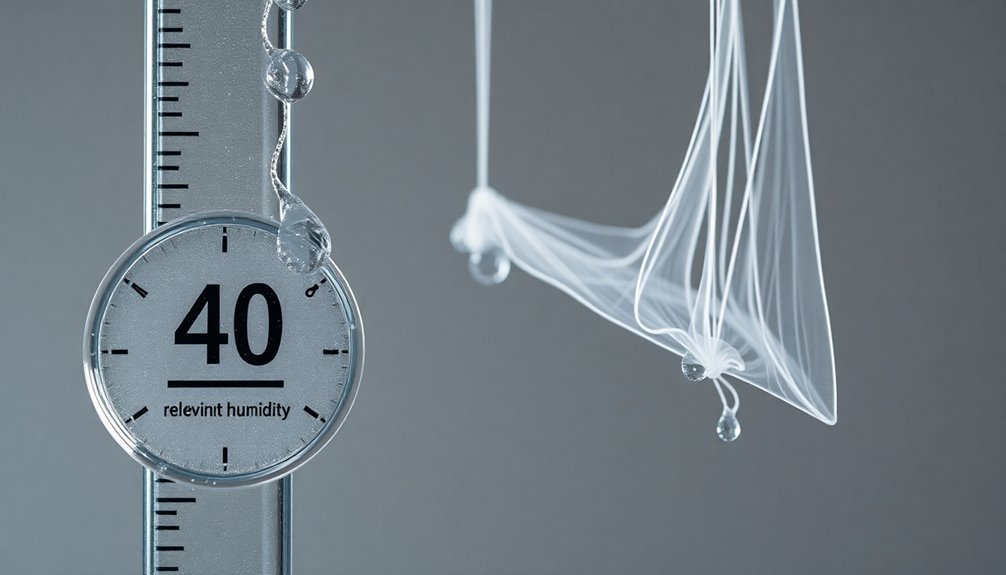
At any given moment, static electricity can build up through a simple transfer of electrons between surfaces. When you touch or rub two objects together, electrons instantly jump from one surface to another, leaving one object positively charged and the other negatively charged.
This process happens more readily with certain materials, as their position on the Triboelectric Series determines how easily they'll gain or lose electrons. Ancient Greek philosopher Thales of Miletus was the first to document this phenomenon over 2,600 years ago.
You'll notice static buildup occurs more frequently in dry conditions because water plays a vital role in managing electrical charges. Even in seemingly dry environments, trace amounts of water molecules create microscopic areas that can harbor and transport electrical charges.
These water ions serve as natural conductors, helping to dissipate static charges between insulating materials.
The environment substantially impacts how static charges develop and persist. When you're in a low-humidity setting, static charges build up more easily and stay longer because there isn't enough moisture in the air to provide a conductive path to the ground.
Additionally, if you repeatedly rub or separate materials, you'll generate increasingly higher levels of static charge, especially if the materials are good insulators.
Ideal Humidity for Static Prevention
Inside most environments, maintaining the right humidity level is essential for preventing static electricity. You'll find that relative humidity (RH) above 55% completely eliminates static buildup, while levels between 40-60% substantially reduce it. When humidity drops below 40%, you're more likely to experience static charges. Colder temperatures tend to increase static electricity problems during winter months.
For ideal static prevention, you'll want to maintain these key humidity levels:
- Keep RH above 40% to prevent excessive static electricity buildup and protect sensitive electronics from discharges.
- Aim for 30-60% RH in industrial settings to balance static prevention with equipment protection.
- Stay below 60% RH to avoid potential moisture-related issues while still maintaining effective static control.
When humidity falls below 30%, you're at higher risk for electrostatic discharges. In fact, at levels under 20% RH, static buildup can reach dangerous levels – up to 6,000 V on workbenches and 35,000 V on carpeted floors.
Since even a 10 V discharge can damage electronic circuits, it's vital to maintain proper humidity. You can achieve this using evaporative humidifiers, air purifiers with built-in humidification, or by controlling ventilation and air circulation in your space.
Static Problems in Low Humidity
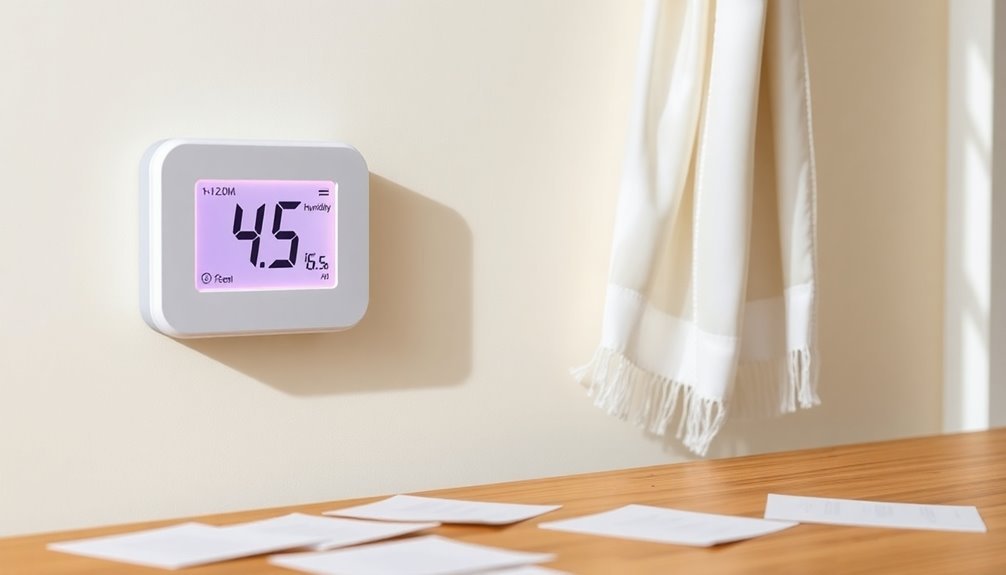
Low humidity environments create a perfect storm for static electricity problems. When relative humidity drops below 40%, you'll notice a substantial increase in static buildup through the triboelectric effect – where materials exchange electrons upon contact.
Without sufficient moisture in the air to act as a natural conductor, these charges can't dissipate properly, leading to an accumulation of static electricity.
You'll face several challenges in low-humidity conditions. Your electronic equipment becomes vulnerable to electrostatic discharge (ESD), which can cause permanent damage. You might experience disruptions in production processes, and your workplace can become uncomfortable due to frequent static shocks. Maintaining temperatures on the cooler side can help since lower temperatures naturally increase relative humidity.
Heat sources in your environment can worsen the situation by further reducing local humidity levels.
To protect yourself and your equipment, you'll need to take active measures. Consider installing humidification systems to maintain relative humidity above 40%. You can use either high-pressure air or evaporative humidifiers to achieve this.
It's also important to implement proper grounding measures, such as using insulating floor mats and grounding tools. By removing unnecessary heat sources and maintaining ideal humidity levels, you'll markedly reduce static electricity risks.
Maintaining Optimal Moisture Levels
You'll need to check your humidity levels daily using a hygrometer, paying special attention to areas where static frequently occurs.
For effective moisture control, establish specific humidity zones in your home or workplace, focusing on rooms with electronics and synthetic materials where static is most problematic.
Position your humidifiers strategically near air returns and in frequently used spaces to maintain a consistent relative humidity above 55%, which effectively prevents static buildup. Static electricity issues are particularly concerning in areas with hot machinery or equipment, as these heat sources create localized dry spots that increase the risk of charge build-up.
Daily Moisture Monitoring Tips
Keeping tabs on your indoor humidity levels plays a crucial role in preventing static electricity buildup. You'll need a reliable hygrometer to monitor moisture levels throughout your space, especially in areas where static commonly occurs.
For optimal health and comfort, aim to maintain relative humidity between 30-50% while managing static.
To effectively monitor your indoor moisture, focus on these key steps:
- Check humidity levels multiple times daily, aiming to keep them between 40% and 60%, with a target of 55% or higher in static-prone areas.
- Pay special attention to spaces near heat-generating equipment, as these areas often develop dry air pockets that can increase static risk.
- Document your readings in a daily log, noting any fluctuations that coincide with static events or equipment operation.
Don't forget to position your hygrometer strategically – place it away from direct heat sources or air vents for the most accurate readings.
If you notice consistently low readings, you'll need to adjust your humidifier settings or consider adding more humidity control devices. Remember that proper monitoring helps you respond quickly to moisture level changes before static becomes a problem.
Targeted Humidity Control Zones
While managing static electricity requires facility-wide humidity control, implementing targeted humidity zones offers a more precise and efficient solution. By dividing your facility into distinct areas with custom environmental settings, you'll achieve the most favorable conditions where they're needed most.
This targeted approach eliminates the limitations of one-size-fits-all systems that often lead to inconsistent humidity levels throughout your space. Centralized control systems allow facility managers to monitor and adjust conditions remotely.
To maintain effective static control, you'll want to keep humidity levels at 55%RH in critical areas. Static electricity becomes problematic below 45%RH but decreases substantially between 45-55%RH. You can achieve these levels using direct room humidifiers or localized spray systems, maintaining consistent relative humidity through proper dew point and temperature management.
Your zoned system should include strategically placed sensors and specialized humidification equipment for precise control. This approach not only improves product quality and process efficiency but also reduces energy consumption by adjusting humidity only where necessary.
When designing your zones, consider physical barriers between areas and guarantee your system can scale as your operations grow. Advanced sensors and AI-driven tools will help you monitor and manage each zone effectively.
Strategic Humidifier Placement Methods
Strategic humidifier placement serves as the cornerstone of effective static control in any facility. To maximize humidity distribution and prevent static buildup, you'll need to position your humidifiers in central locations, at least 2-4 feet above the ground. This elevated placement guarantees even moisture dispersal while preventing water damage to floors and furnishings. Ultrasonic humidifiers work especially quietly and effectively in larger spaces.
For ideal static prevention, you'll want to maintain humidity levels above 55% RH throughout your space. Use a hygrometer to identify low-humidity areas and adjust your humidifier placement accordingly.
Keep units away from air vents, electronic devices, and direct sunlight to prevent uneven distribution and equipment damage.
Here's how to strategically place humidifiers for maximum static control:
- Position larger units in central areas with good airflow, guaranteeing they're elevated on stable surfaces
- Install whole-house systems between the air return duct and furnace for thorough coverage
- Place smaller units on tables or cabinets in targeted zones where static is most problematic
For industrial settings, consider using localized spray systems or ceiling-mounted atomizing nozzles near heat-generating equipment to address specific dry micro-climates that contribute to static electricity.
Humidifiers for Static Control
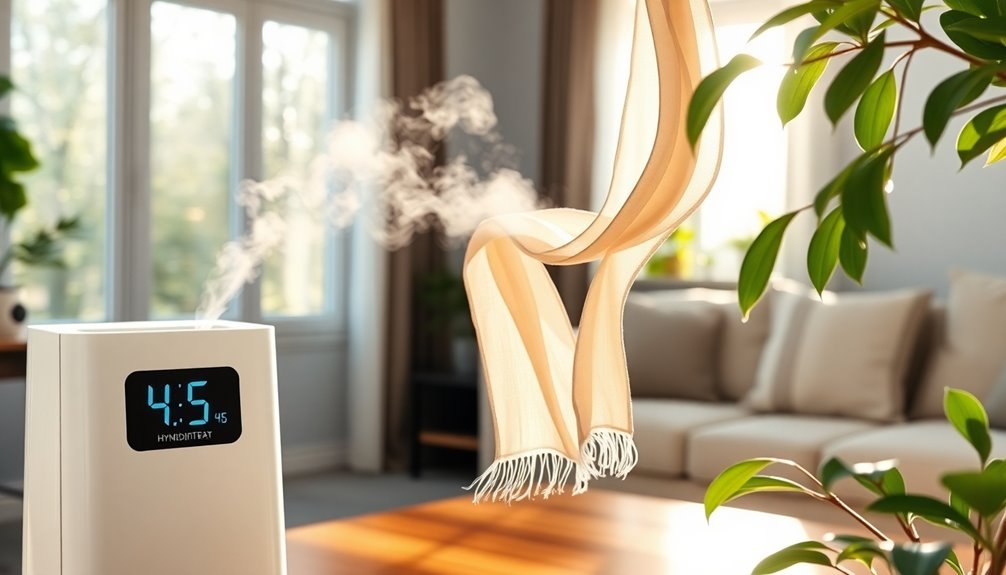
By properly managing your humidifier setup, you can effectively combat static electricity in indoor environments. You'll want to maintain humidity levels above 55% RH to prevent static buildup, as levels below 45% RH substantially increase the risk of static discharge.
You've got several humidifier options to choose from. Steam humidifiers use electricity to generate moisture, while indirect steam systems offer precise control through modulating valves.
For specific areas around heat-generating equipment, you can install localized spray systems. If you don't have access to a steam boiler, electric steam humidifiers are your best bet.
To implement an effective system, you can mount atomizing nozzles in ceiling spaces or install direct room humidifiers for large manufacturing areas. Individual nozzles on machines provide targeted humidity control where you need it most.
You'll want to use humidistats to monitor and adjust settings automatically.
Remember that while high humidity prevents static buildup, it can also cause condensation and corrosion if not properly managed. You'll need to balance humidity levels carefully – staying above 55% RH to control static but monitoring carefully to prevent moisture-related issues in your equipment.
Commercial Static Prevention Solutions
Commercial facilities can choose between industrial humidification equipment and spray ionization systems to combat static electricity effectively.
Industrial humidifiers maintain ideal moisture levels throughout large spaces. This is crucial because low humidity is a key contributor to static charge accumulation on surfaces. Maintaining humidity levels between 40 and 60 percent, or more specifically between 45 and 55 percent, helps prevent the buildup of static electricity. This can be achieved by using humidifiers in your facility, which add moisture to the air, making it a natural conductor that grounds potential static charges[3".
Spray ionization systems, on the other hand, neutralize static charges directly at problem areas. These systems can be particularly effective in areas where industrial machines generate heat and create dry micro-climates that encourage static buildup. Localized spray systems can be employed to raise the humidity in these specific areas, ensuring that static charges do not build up.
These solutions work together with your existing static prevention measures to create a thorough approach for maintaining proper humidity levels and reducing static buildup in your facility. Other measures include grounding conductive objects, using ESD floor coatings or coverings, placing down anti-static floor mats, and ensuring employees wear anti-static clothing and use anti-static wrist straps.
Industrial Humidification Equipment
Modern industrial facilities rely heavily on specialized humidification equipment to combat static electricity issues that can disrupt operations and damage products. You'll find direct room humidifiers and atomizing nozzles working together to maintain ideal humidity levels around 55% RH, where static charges naturally dissipate through moisture in the air.
To effectively control static, you'll need a well-designed system that includes:
- Localized spray systems positioned near hot machinery to prevent dry air pockets from forming
- Atomizing nozzles that distribute a fine mist throughout your facility's critical areas
- Control systems that monitor and adjust humidity levels to maintain consistent conditions
When you're setting up your industrial humidification system, it's vital to think about your specific application needs. You can target different zones with varying humidity requirements, from packaging areas to electronics assembly lines.
Your system should be capable of maintaining steady humidity levels above the 45% RH threshold where static begins to dissipate. By implementing the right combination of humidification equipment, you'll protect sensitive materials and guarantee smooth production processes while reducing operational costs through efficient moisture distribution.
Spray Ionization Systems
Beyond humidity control, spray ionization systems offer a powerful approach to combat static electricity in commercial environments. These systems generate both positive and negative ions using high voltage applied to sharp points, effectively neutralizing static charges on non-conductive surfaces.
You'll find two main types of ionization systems: AC and DC. AC ionizers alternate current pulses to break down air molecules, while DC systems require additional power supplies to switch polarity.
The pulse AC method generates more ions than conventional approaches, and you can adjust the ratio of positive to negative ions for the best performance.
For large-scale applications, you'll want to think about bar-type ionizers, which can deliver ions across wide areas up to 3 meters. High-performance systems like the SJ-H Series can eliminate static in as little as 0.5 seconds while maintaining an impressive ion balance of +/- 1V.
You can implement these systems across various industries, from electronics assembly to pharmaceutical manufacturing. They're particularly effective in warehouses, clean rooms, and static-sensitive environments.
Modern ionizers feature low maintenance requirements and often include visual indicators to verify they're working correctly.
Home Static Control Methods

Static-prone homes can benefit from several practical control methods that effectively reduce electrical charges in your living space. You'll find that maintaining proper humidity levels between 30-50% RH serves as your first line of defense against unwanted static buildup.
Install humidifiers throughout your home, or consider a whole-home humidification system for exhaustive coverage.
Your choice of materials plays a vital role in static control. Opt for natural fabrics like cotton and wool instead of synthetic materials, and use leather-soled shoes rather than rubber ones.
You can also treat your existing fabrics and surfaces with anti-static sprays or dryer sheets to neutralize electrical charges.
Start your laundry routine by adding fabric softener to clothes and removing them while slightly damp.
Keep indoor plants like Boston ferns and peace lilies to naturally increase humidity through transpiration.
Ground yourself by touching metal objects before handling electronics or sensitive items.
For additional protection, moisturize your skin regularly and consider sealing potential dry air sources, such as crawl space vents.
Adding baking soda to your laundry creates an extra barrier against static charges, while localized humidification systems can address specific problem areas in your home.
Monitoring Humidity Year Round
Consistent humidity monitoring throughout the year plays a crucial role in preventing static electricity and maintaining a comfortable home environment. You'll want to keep your indoor humidity levels between 30% and 60% to prevent static buildup and protect your health.
To track humidity effectively, you'll need reliable monitoring tools. Digital hygrometers offer essential features, including temperature readings and humidity history tracking.
If you're looking for automated solutions, smart home systems can monitor levels in real-time and adjust your humidity control devices automatically.
You'll need different strategies for each season. During winter, use humidifiers and seal any leaks to maintain moisture levels.
In summer, you might need dehumidifiers or increased ventilation to reduce excess humidity. Consider using natural methods like opening windows or running extraction fans when weather permits.
For the most effective results, you might want to invest in a whole-home humidity control system. These systems integrate with your existing HVAC setup and provide consistent humidity management throughout your house.
Remember to choose appropriately sized equipment based on your home's square footage, and opt for continuous monitoring rather than occasional checks.
Industry Standards for Static Protection
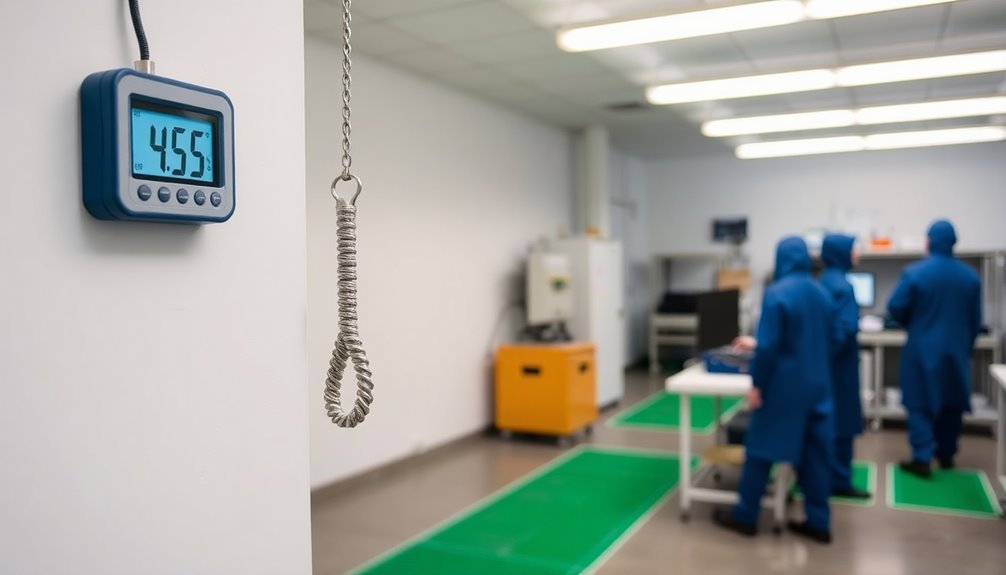
You'll find that major industry standards like ANSI/ESD S20.20 and IEC 61340-5-1 recommend maintaining relative humidity between 30-70% to minimize static electricity risks in electronics manufacturing environments.
These standards include thorough guidelines for protecting sensitive equipment through proper grounding systems, ESD-safe materials, and controlled workplace conditions.
When working with specialized electronic components, you're required to follow even stricter standards like JEDEC JESD625B for semiconductors or MIL-STD-1686 for military applications, which specify detailed protocols for static-sensitive device handling.
Recommended RH Safety Ranges
According to industry standards, maintaining relative humidity (RH) between 30-70% is vital for protecting against electrostatic discharge (ESD) in sensitive environments. While this range is acceptable, you'll get the best results by keeping RH between 40-60%, which prevents static issues without risking corrosion damage to your electronic components.
You should understand that humidity control isn't a complete solution on its own. Even at 90% RH, static charges can still develop, so don't rely solely on humidity as your primary ESD protection method. Instead, use it as a backup to complement your existing ESD safeguards.
For ideal ESD protection in your facility, follow these key guidelines:
- Monitor both temperature and relative humidity regularly to maintain proper absolute humidity levels
- Install humidity control systems in areas with heat-generating equipment that can create dry air pockets
- Test your ESD protective materials under various humidity conditions to verify consistent performance
Remember that while higher humidity helps dissipate static charges through increased surface conductivity, it's important to balance this benefit against potential risks like corrosion and personnel comfort.
Equipment Protection Guidelines
Proper equipment protection forms the foundation of any effective static control program. You'll need to implement thorough grounding and bonding systems while verifying all conductive parts are electrically connected. Regular inspections of these systems are vital to maintain top-notch static protection.
| Protection Element | Purpose | Implementation |
|---|---|---|
| Antistatic Mats | Protect sensitive equipment | Place at all workstations |
| Wrist Straps | Ground personnel | Wear during equipment handling |
| Ionizers | Neutralize static charges | Install in work areas |
| ESD-Safe Tools | Prevent charge transfer | Use for all maintenance |
| Dissipative Surfaces | Control static discharge | Install on workbenches |
To comply with ANSI/ESD S20.20 and IEC 61340-5-1 standards, you'll want to set up workstations with proper dissipative surfaces and maintain humidity control systems. Your equipment protection strategy should include regular verification of grounding systems and ESD-safe materials. Don't forget to implement proper handling procedures for non-conductive materials, as they can substantially contribute to static buildup. When setting up your workspace, verify all equipment is properly grounded and positioned to minimize static risk, while maintaining easy access for regular maintenance and testing.
Seasonal Humidity Adjustments
The dramatic shift in humidity levels between seasons requires careful attention to maintain an environment that prevents static buildup. You'll notice that winter brings particularly challenging conditions, as cold air and heating systems create an exceptionally dry environment where static electricity thrives.
To combat this, you'll need to maintain humidity levels between 40-60%, with levels above 55% being most effective at preventing static charges.
While summer's naturally higher humidity helps reduce static electricity, don't assume you're completely protected. Air conditioning systems can create pockets of dry air, leading to unexpected static buildup in your workspace. You'll need to monitor and adjust humidity levels year-round, regardless of the season.
Here's what you should track throughout the year:
- Daily indoor humidity readings, especially in areas with heat-generating equipment
- Local weather patterns and their impact on your facility's humidity levels
- Performance of your climate control systems, including humidifiers and dehumidifiers
For ideal results, use humidistats to automate humidity control, and implement localized humidification solutions in areas where static-sensitive equipment operates. Remember to adjust your approach based on your region's specific climate conditions, as different locations may require vastly different humidity management strategies.
Frequently Asked Questions
Can Static Buildup Damage Electronic Devices Even at Recommended Humidity Levels?
Yes, you can still experience static damage at recommended humidity levels. While proper humidity reduces the risk, you'll need additional protective measures like anti-static mats and grounding straps for complete device protection.
How Quickly Does Humidity Need to Increase to Prevent Static Discharge?
While there's no specified timeframe for humidity increases, you'll want to raise levels above 55% RH as soon as possible. Once you reach this level, you'll effectively prevent static discharge in your environment.
Do Air Purifiers Affect the Effectiveness of Humidifiers for Static Control?
No, your air purifier won't affect your humidifier's ability to control static. They work independently, so you can safely use both together to maintain clean air while adding the moisture needed for static control.
What Materials Are Most Susceptible to Static Damage in Borderline Humidity?
You'll find electronics and PCBs are most vulnerable to static damage in borderline humidity, followed by plastics and synthetic textiles. Even with 40-60% humidity, these materials still require ESD protection measures.
Does the Height of Humidifier Placement Affect Static Prevention Effectiveness?
Yes, your humidifier's height directly impacts static prevention. You'll get better results placing it 2-4 feet high, as this allows proper mist distribution throughout the room rather than settling on the floor.
In Summary
Preventing static buildup doesn't have to be complicated. Keep your home's humidity between 30-50% during winter months, 40-60% in warmer seasons, and 45-55% for electronics-heavy areas. You'll notice fewer shocks, better air quality, and protected electronics. If you're struggling with static, check your humidity levels first – they're often the root cause. Install a reliable humidifier and humidity monitor for best results.

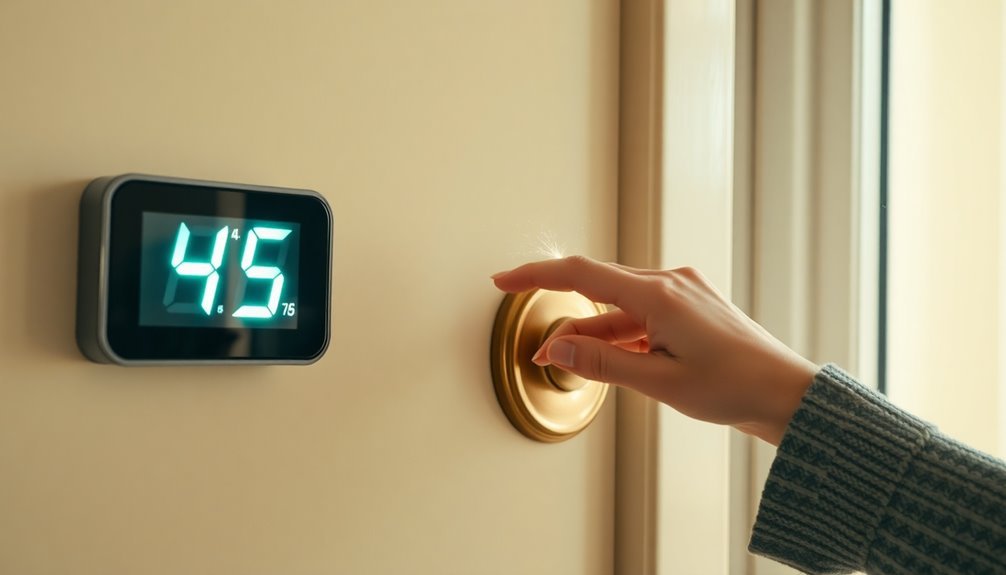



Leave a Reply